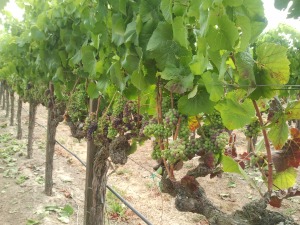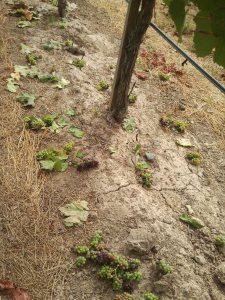In regions where there is plenty of sunlight, fertile soil and irrigation, grapevines can end up producing too much fruit. This is the case in many winegrowing regions in California. In response, we typically remove a percentage of the clusters around this time of year–after they are fully formed but long before they are ripe. Removing a portion of these immature clusters allows the vine to put all of its energy into the remaining clusters and leads to a more even ripening process and improved flavor compounds.
Removing fruit may seem detrimental since it decreases our yield and, ultimately, the amount of wine produced. However, our intention is better quality wine, not more wine. Green harvest allows us to achieve better quality wine by creating balanced vines with the right cluster-to-canopy-size ratio and more evenly ripened clusters at harvest.
Below are some recent pictures of a walk through dropping fruit, when veraison (the turning of the grapes from green to red) is 20-30% complete. All but 2 clusters are removed from shoots that have extended beyond the top wire, all but 1 cluster are removed from shoots that extend below the top wire and all the clusters are removed from shoots that are too short to reach the middle wire. When veraison is done, we do a second round and drop all the clusters that did not ripen properly so that we end up with an evenly ripened crop.



Leave a comment